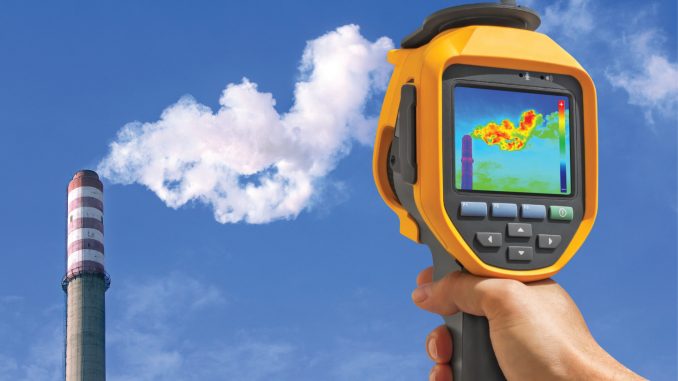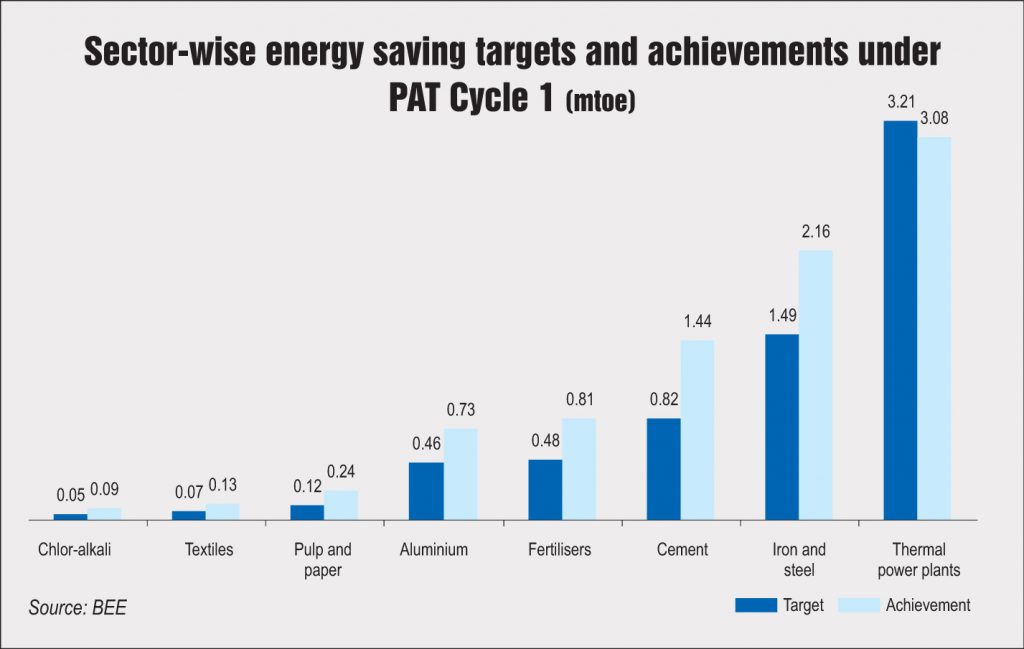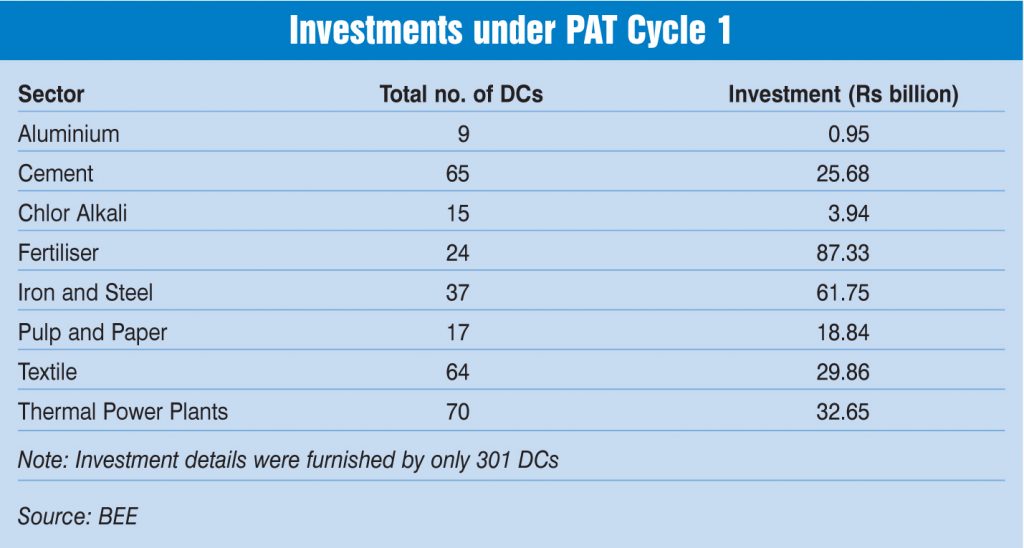
The perform, achieve and trade (PAT) is one of the flagship schemes launched by the Bureau of Energy Efficiency (BEE) in April 2012 under the National Mission for Enhanced Energy Efficiency, which is one of the eight missions under the National Action Plan on Climate Change. The scheme aimed at improving the energy efficiency of large-scale industries and creating a market-based mechanism to incentivise energy savings by converting these savings to a tradable instrument.
PAT has had a strategic impact on industries by demonstrating a significant reduction in energy consumption. The first PAT cycle, which covered 478 industrial units in eight industrial sectors over a period of three years (2012 to 2015), showed that these energy-intensive units together exceeded their energy saving targets by about 30 per cent. As per BEE estimates, these units accounted for 2 per cent of the country’s total commercial energy consumption. The co-benefit has been an emission reduction of almost 35 per cent more than the target.
While 75 per cent of the industrial units met their targets, the remaining units were entitled to purchase energy saving certificates (ESCerts) from industries that overachieved their targets. Subsequently, there was initiation of trading of ESCerts at the power exchanges in September 2017. Until January 2018, 17 trading sessions took place with around 1.3 million ESCerts having been traded. Those industrial units, that participated in it, were able to achieve a compliance of about 90 per cent.
PAT is a multi-cycle scheme and is now in its second cycle of implementation for the period 2016-17 to 2018-19. This time, the cycle covers more number of units and newer sectors (621 designated consumers [DCs] from 11 sectors). Since this cycle is in its last year of implementation, PAT Cycle III has been notified by the Ministry of Power (MoP).
Power Line presents a round-up of the PAT scheme, its outcomes so far, ESCert trading and future PAT cycle targets…
PAT Cycle I
Under PAT Cycle I, which began in 2012 and concluded in March 2015, 478 industrial units (DCs) across eight sectors – aluminum, cement, chlor-alkali, fertiliser, iron and steel, paper and pulp, thermal power and textiles – were given energy savings targets. The thermal power sector accounted for the highest share (30 per cent) across these sectors. The units were required to cumulatively achieve 4.05 per cent reduction in their average energy consumption by the end of the cycle, or an annual reduction of around 6.686 million tonnes of oil equivalent (mtoe) of energy and approximately 23 mt of carbon dioxide. The thermal power sector was given 48 per cent of the target.
Based on third-party verification at the end of the three-year period, the results showed that the energy saving target was exceeded by 30 per cent under this phase, with total energy savings of about 8.67 mtoe. There was a reduction of 5.03 per cent in baseline energy consumption as opposed to the 4.05 per cent target. Besides, there was a reduction of 31 million tonnes of carbon dioxide emissions, which was higher than the target. The energy savings were equivalent to Rs 95 billion in monetary terms. Around 75 per cent of the industries reached and overachieved their prescribed targets.
Reportedly, the industries made an investment of about Rs 261 billion in the first PAT cycle to undertake energy efficiency measures. The private sector’s share in the total investments was the highest at 52 per cent. Industry-wise, the maximum investments were made in the fertiliser sector (33 per cent) followed by the iron and steel sector (24 per cent share).
Sector-wise, except thermal power generation plants, all sectors managed to significantly overachieve their targets. The thermal power segment missed the prescribed target by 5 per cent (the target was 3.21 mtoe while the segment achieved 3.06 mtoe). However, overall, the sector contributed to nearly 35 per cent of the overall target, which was the maximum contribution by any sector.
The thermal power industry undertook a number of measures to meet their targets under the first phase. According to the BEE, most of the thermal power plants (TPPs) invested in the least payback option of auxiliary power consumption by switching to LED lamps, installing variable frequency drives and carrying out stage reduction in pumps. Further, plants adopted measures like the use of washed coal, dynamic coal balancing, intelligent sootblowing systems, waste heat recovery systems, and vapour absorption machines. to lower their energy consumption.
The sectors which were able to achieve maximum targets under PAT cycle are: paper and pulp (143 per cent), textiles (95 per cent), cement (81.6 per cent), chlor-alkali (72 per cent), fertiliser (64 per cent), aluminium (60 per cent) and iron and steel (41 per cent).
ESCert trading
Under the PAT scheme, industrial units are obligated to meet their energy efficiency targets either by undertaking energy efficiency measures themselves or by buying ESCerts from other industries. ESCerts are issued when energy efficiency improvements surpass the targets. For every one mtoe of improvement in target, one ESCert is issued.
In February 2017, the MoP issued ESCerts to all DCs who overachieved their targets. Around 110 DCs were entitled to purchase 1.4 million ESCerts to meet the shortfall towards meeting their energy saving targets.
Further, to enable trading, the Central Electricity Regulatory Commission (CERC) had devised a regulatory framework by approving the ESCerts transaction procedures in February 2017. In March 2017, the CERC issued an order on the fees and charges of ESCerts registry. Later, in May 2017, it approved the amendments to the by-laws and rules of the power exchanges under CERC’s power market regulations to enable ESCerts transactions on the power exchange platforms.
Designated industries need to register as an eligible entity for trading. This registration can be done on the PATNet portal. While the BEE administers the trading of these certificates, Power System Operation Corporation Limited performs the duties of the registry.
These ESCerts are traded every Tuesday at the power exchanges through a double-sided uniform price auction. However, of the two exchanges, the ESCerts trading takes place only at the Indian Energy Exchange (IEX).
Further, unlike renewable energy certificates, ESCerts do not have floor or ceiling prices under the CERC regulations and the price is discovered competitively based on the buy-sell dynamics. During any trading session, an eligible entity is not allowed to bid in excess of the total ESCerts held in its registry account. In case of any breach, eligible entities will be treated as defaulters, and their bids will not be considered in the price discovery.
As per trading data provided by the IEX, till January 16, 2018 which was the last trading session under PAT Cycle I, a total of 17 trading sessions were held. The last trading session was earlier supposed to be held on December 31, 2017 but was extended to January 16, 2018. Recently, the BEE has issued a circular stating that the trading of ESCerts for PAT Cycle I will resume from February 27, 2018, wherein the same set of buyers and sellers under PAT Cycle I will be eligible for the trading of banked ESCerts.
Overall, the volumes traded have been on the lower side. Given that the total demand for ESCerts, which were expected to be traded during the first cycled, was about 1.42 million ESCerts, only 1.298 million ESCerts were traded. The traded ESCerts represented around 90 per cent of the total obligation.
The average number of participants in these trading sessions was around 67. Overall, all DCs which were registered on IEX on the buyers side (97) met their compliance requirement fully. The only exception was the DCs from the textiles sector, which achieved only 87 per cent compliance level.
The market price discovered during the 17 trading sessions has varied widely given that there are no floor or forbearance prices. These ranged from Rs 200 per ESCert to Rs 1,200 per ESCert. The highest number of ESCerts (449,000) was traded on December 19, 2017, which alone amounted to about 35 per cent of the total trade at the IEX.
PAT Cycle II and beyond
PAT Cycle II commenced from April 2016 covering 11 sectors (eight existing sectors and three new sectors), railways, electricity discoms and refineries. In total, 621 DCs, which include 448 DCs from existing sectors, 89 new DCs from existing sectors and 84 new DCs from new notified sectors, have been covered in this cycle. Further, energy savings of 8.87 mtoe is expected during the compliance period 2016-17 to 2019-20. The target for emission reduction has been set at 60 mt of CO2.
PAT Cycle III was notified in March 2017 and it covers 116 DCs across six sectors – TPPs, cement, aluminium, pulp and paper, iron and steel, and textile for the compliance period 2017-18 to 2019-20. The energy reduction target for this cycle is 1.06 mtoe. The energy consumption of these DCs is 35 mtoe. New DCs are expected to be notified annually. Thus, with PAT Cycles II and III, 737 DCs have been given the target to reduce their energy consumption by 9.929 mtoe by 2020.
For PAT Cycle IV, the BEE plans to include commercial buildings and the petrochemical industry.
Conclusion
As India works towards meeting its climate change targets, energy efficiency will play a key role. However, there are some concerns regarding the overachievement of targets under Cycle I owing to low target setting, inadequacy of penalties for industries that fail to meet their targets, and the enforcement mechanism, among others. In addition, greater awareness is needed as DCs, which are obligated to buy ESCerts are yet to register on the exchanges for trading. In spite of these challenges, the PAT scheme has successfully transformed the energy efficiency landscape with industries taking proactive measures to align their productivity goals with these programmes.






